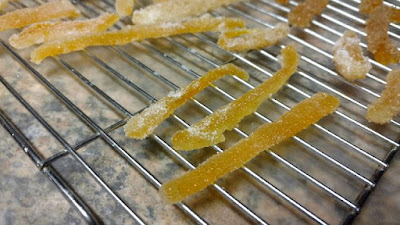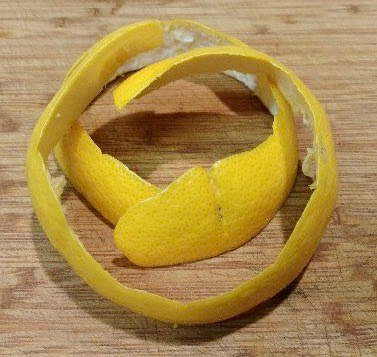
Recipe: Candied citrus peel is an old-fashioned favorite

Candied citrus peel dries on a rack. The treat is
easy to make from peel you might otherwise discard. (Photos: Debbie Arrington)
|
Candied citrus peel is the original sweet and sour treat. Easy to make, this old-fashioned candy uses what normally would be discarded – the outer peel of oranges, lemons or grapefruit.
“To me, (it’s) the perfect way to end a large meal,” says cookbook author Mark Bittman, the former New York Times food columnist.
Choose thick-skinned varieties of citrus such as navel or Valencia oranges, Eureka or Meyer lemons or grapefruit (especially pink or Cocktail grapefruit). Cara Cara oranges work, too.
The peel is simmered in water to soften the bitter white pith and make it easy to scrape off. Then, the peel is cut into long strips and simmered in syrup. After absorbing the syrup, the peel strips are rolled in sugar, then dried. Covered with sweetness, the peel hardens as it dries.

Grapefruit peel takes a little more work to
candy than orange peel does, but it's worth it.
|
Grapefruit needs a little extra work. Boil it three times, changing the water each time, to remove any bitterness.
As for sugar, try rolling the peel pieces in demerara sugar. The large granules add crunch along with the sweet-sour flavor.
Candied citrus peel
Comments
0 comments have been posted.Sacramento Digs Gardening to your inbox.
Sites We Like
Garden Checklist for week of July 21
Your garden needs you!
* Keep your vegetable garden watered, mulched and weeded. Water before 8 a.m. to reduce the chance of fungal infection and to conserve moisture.
* Feed vegetable plants bone meal, rock phosphate or other fertilizers high in phosphate to stimulate more blooms and fruiting. (But wait until daily high temperatures drop out of the 100s.)
* Don’t let tomatoes wilt or dry out completely. Give tomatoes a deep watering two to three times a week.
* Harvest vegetables promptly to encourage plants to produce more. Squash especially tends to grow rapidly in hot weather. Keep an eye on zucchini.
* Pinch back chrysanthemums for bushy plants and more flowers in September.
* Remove spent flowers from roses, daylilies and other bloomers as they finish flowering.
* Pinch off blooms from basil so the plant will grow more leaves.
* Cut back lavender after flowering to promote a second bloom.
* It's not too late to add a splash of color. Plant petunias, snapdragons, zinnias and marigolds.
* From seed, plant corn, pumpkins, radishes, winter squash and sunflowers.